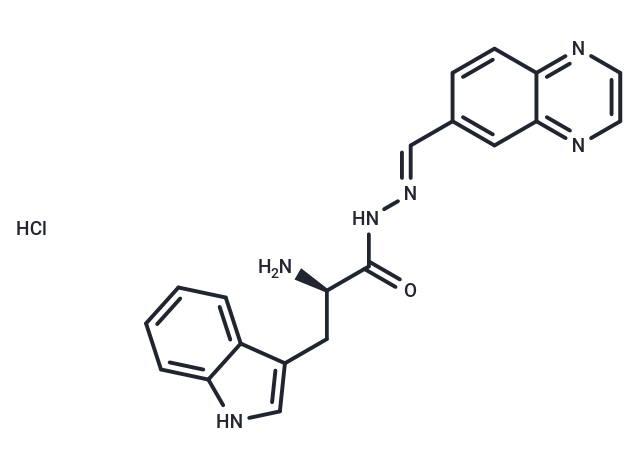Shopping Cart
- Remove All
 Your shopping cart is currently empty
Your shopping cart is currently empty

Rhosin hydrochloride is a specific inhibitor of the RhoA subfamily Rho GTPases and inhibits the RhoA-GEF interaction. Rhosin hydrochloride can significantly induce cell apoptosis without affecting cell cycle progression. [1]

| Pack Size | Price | Availability | Quantity |
|---|---|---|---|
| 1 mg | $162 | In Stock | |
| 2 mg | $229 | In Stock | |
| 5 mg | $347 | In Stock | |
| 10 mg | $497 | In Stock | |
| 25 mg | $793 | In Stock | |
| 50 mg | $1,080 | In Stock | |
| 100 mg | $1,450 | In Stock | |
| 1 mL x 10 mM (in DMSO) | $382 | In Stock |
| Description | Rhosin hydrochloride is a specific inhibitor of the RhoA subfamily Rho GTPases and inhibits the RhoA-GEF interaction. Rhosin hydrochloride can significantly induce cell apoptosis without affecting cell cycle progression. [1] |
| Targets&IC50 | RhoA:(kd)0.4 uM |
| In vitro | METHODS: To investigate the cytotoxic effects of Rhosin hydrochloride on B16BL6 and 4T1 cells, cell viability was assessed by treating cells with 1-100 μM Rhosin hydrochloride. RESULTS Rhosin hydrochloride at a concentration of 100 μM induced cell death in B16BL6 and 4T1 cells. [1] |
| In vivo | METHODS: B16BL6 cells and 4T1 cells were injected into the tail vein of syngeneic C57BL/6J mice and Balb/c mice. Mice were treated with 10 or 30 mg/kg of Rhosin hydrochloride daily from day 1 to day 14. RESULTS The number of lung metastatic nodules in B16BL6 and 4T1 cells was reduced in a dose-dependent manner after administration of Rhosin hydrochloride, and Rhosin hydrochloride inhibited the metastasis of 4T1-luc tumor cells to the lung region, which could be confirmed by the reduction of photon flux. [1] |
| Molecular Weight | 431.318 |
| Formula | C20H20Cl2N6O |
| Cas No. | 1281870-42-5 |
| Smiles | Cl.N[C@H](Cc1c[nH]c2ccccc12)C(=O)N\N=C\c1ccc2nccnc2c1 |
| Relative Density. | no data available |
| Storage | store at low temperature | Powder: -20°C for 3 years | In solvent: -80°C for 1 year | Shipping with blue ice. | |||||||||||||||||||||||||||||||||||
| Solubility Information | DMSO: 100 mg/mL (253.25 mM), Sonication is recommended. | |||||||||||||||||||||||||||||||||||
Solution Preparation Table | ||||||||||||||||||||||||||||||||||||
DMSO
| ||||||||||||||||||||||||||||||||||||

Copyright © 2015-2025 TargetMol Chemicals Inc. All Rights Reserved.